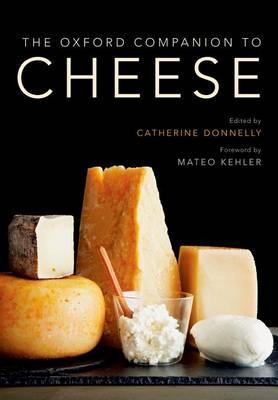Oxford Companion to Cheese

Oxford Companion to Cheese
standardized cheese, cheesemakers, cheesemongers, affineurs, and most of all consumers are rediscovering the endless variety of cheeses across cultures.
The Oxford Companion to Cheese is the first major reference work dedicated to cheese, containing 855 A-Z entries on cheese history, culture, science, and production. From cottage cheese to Camembert, from Gorgonzola to Gruyere, there are entries on all of the major cheese varieties globally, but also many cheeses that are not well known outside of their region of production. The concentrated whey cheeses popular in Norway, brunost, are covered here, as are the traditional Turkish
and Iranian cheeses that are ripened in casings prepared from sheep's or goat's skin. There are entries on animal species whose milk is commonly (cow, goat, sheep) and not so commonly (think yak, camel, and reindeer) used in cheesemaking, as well as entries on a few highly important breeds within each species,
such as the Nubian goat or the Holstein cow. Regional entries on places with a strong history of cheese production, biographies of influential cheesemakers, innovative and influential cheese shops, and historical entries on topics like manorial cheesemaking and cheese in children's literature round out the Companion's eclectic cultural coverage.
The Companion also reflects a fascination with the microbiology and chemistry of cheese, featuring entries on bacteria, molds, yeasts, cultures, and coagulants used in cheesemaking and cheese maturing. The blooms, veins, sticky surfaces, gooey interiors, crystals, wrinkles, strings, and yes, for some, the odors of cheese are all due to microbial action and growth. And today we have unprecedented insight into the microbial complexity of cheese, thanks to advances in molecular biology,
whole-genome sequencing technolog
PRP: 465.00 Lei
Acesta este Prețul Recomandat de Producător. Prețul de vânzare al produsului este afișat mai jos.
372.00Lei
372.00Lei
465.00 LeiLivrare in 2-4 saptamani
Descrierea produsului
standardized cheese, cheesemakers, cheesemongers, affineurs, and most of all consumers are rediscovering the endless variety of cheeses across cultures.
The Oxford Companion to Cheese is the first major reference work dedicated to cheese, containing 855 A-Z entries on cheese history, culture, science, and production. From cottage cheese to Camembert, from Gorgonzola to Gruyere, there are entries on all of the major cheese varieties globally, but also many cheeses that are not well known outside of their region of production. The concentrated whey cheeses popular in Norway, brunost, are covered here, as are the traditional Turkish
and Iranian cheeses that are ripened in casings prepared from sheep's or goat's skin. There are entries on animal species whose milk is commonly (cow, goat, sheep) and not so commonly (think yak, camel, and reindeer) used in cheesemaking, as well as entries on a few highly important breeds within each species,
such as the Nubian goat or the Holstein cow. Regional entries on places with a strong history of cheese production, biographies of influential cheesemakers, innovative and influential cheese shops, and historical entries on topics like manorial cheesemaking and cheese in children's literature round out the Companion's eclectic cultural coverage.
The Companion also reflects a fascination with the microbiology and chemistry of cheese, featuring entries on bacteria, molds, yeasts, cultures, and coagulants used in cheesemaking and cheese maturing. The blooms, veins, sticky surfaces, gooey interiors, crystals, wrinkles, strings, and yes, for some, the odors of cheese are all due to microbial action and growth. And today we have unprecedented insight into the microbial complexity of cheese, thanks to advances in molecular biology,
whole-genome sequencing technolog
Detaliile produsului









